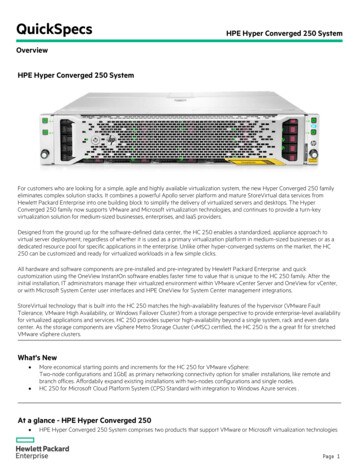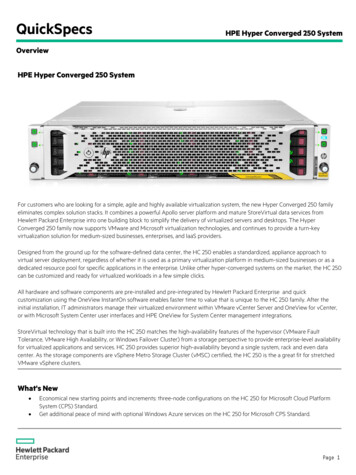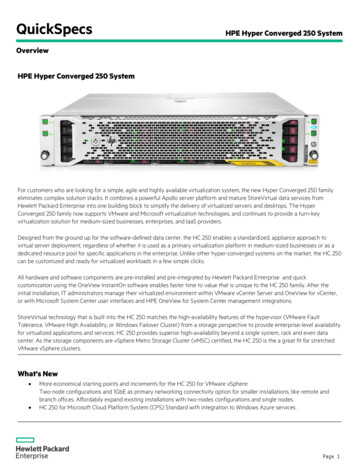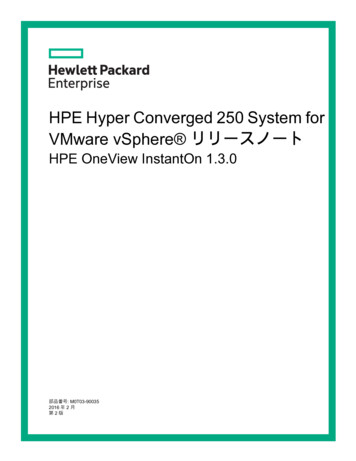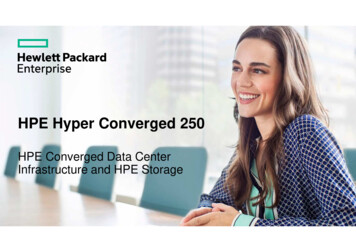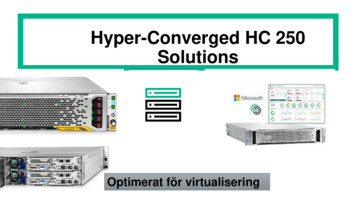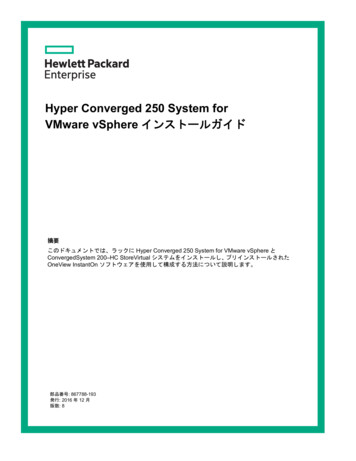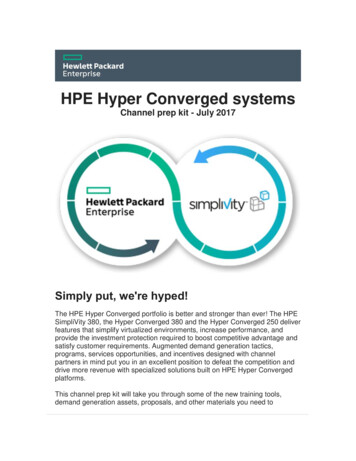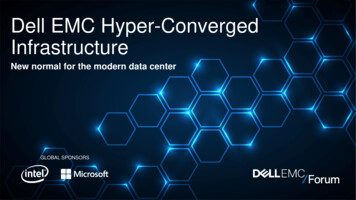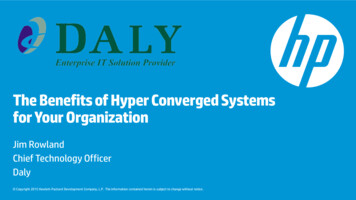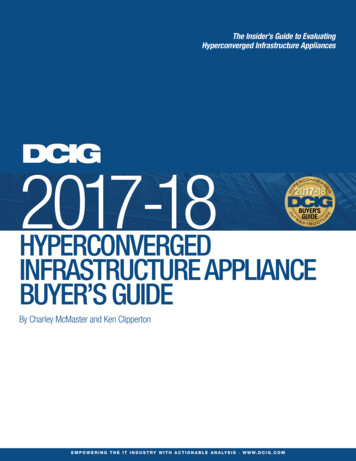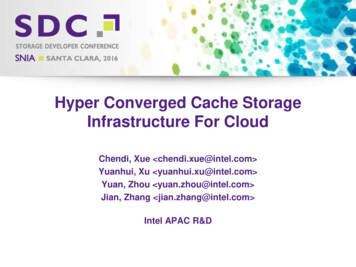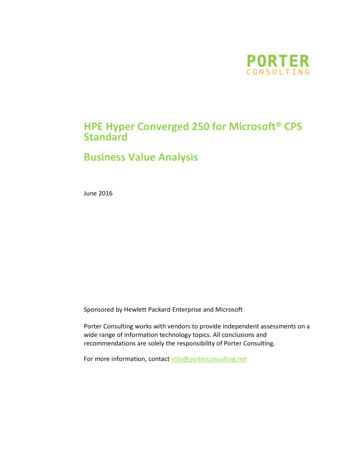
Transcription
HPE Hyper Converged 250 for Microsoft CPSStandardBusiness Value AnalysisJune 2016Sponsored by Hewlett Packard Enterprise and MicrosoftPorter Consulting works with vendors to provide independent assessments on awide range of information technology topics. All conclusions andrecommendations are solely the responsibility of Porter Consulting.For more information, contact info@porterconsulting.net
ContentsExecutive Summary. 1Introduction - Hyperconvergence Business Drivers . 1Hyperconverged Infrastructure Solutions Transform IT Agility and Economics . 2HPE HC250 for Microsoft CPS Standard System Overview . 4HC250 for Microsoft CPS Standard System TCO and ROI Analysis . 5Conclusion – HC250 for Microsoft CPS Standard System Lives up to the Hype . 8Appendix: ROI Terminology . 9
Executive SummaryBusinesses are looking at server and desktop virtualization solutions, cloud-basedservices and agile development practices to accelerate the pace of innovation andimprove economics. But legacy IT implementations composed of discrete compute,storage and storage area networking (SAN) platforms often can’t meet the increasedagility, scalability and price-performance demands of today’s virtualized ITenvironments.Microsoft CloudPlatform Systemprovides an Azureconsistent cloud-in-abox for virtualizedWindows and Linux workloads. Aimed atmidsized businessesand smallerenterprises, CPSStandard is a fullyintegrated and preconfigured systemcombining a highperformance hardwareplatform and provenMicrosoft software.The turnkey solutionaccelerates time-tovalue and simplifiesoperations.Many organizations are evaluating hyperconverged infrastructure solutions to supportMicrosoft Hyper-V and Microsoft VDI deployments and Azure hybrid cloud initiatives.Hyperconverged appliances have the potential to transform economics and accelerateservice agility by eliminating SANs and consolidating compute and storage resourcesinto compact x86 building blocks that are virtualized and uniformly administered.But does hyperconvergence really live up to the hype? Is hyperconverged infrastructuresignificantly more efficient and cost-effective than traditional IT infrastructure? Are newhyperconverged appliances easily tied into standard Microsoft administrative systemsand practices? Porter Consulting took a look at the Hewlett Packard Enterprise HyperConverged (HC) 250 for Microsoft Cloud Platform System (CPS) Standard to find out.This report explores some of the business requirements and technology trends drivinghyperconvergence adoption. It reviews the functional capabilities and business benefitsof hyperconverged appliances in general and the HPE HC250 for Microsoft CPS Standardin particular. We take a look at how the HPE product supports key Microsofttechnologies and services like Hyper-V, System Center and Azure. And we examine thebusiness advantages of the appliance for virtualized IT by comparing it to a conventionalsiloed IT implementation based on standalone compute, storage and SAN solutions.After analyzing both approaches Porter concludes the HPE HC250 for Microsoft CPSStandard offers significant business value especially in the critical areas of time-tovalue, IT service agility and total cost of ownership (TCO). In addition, factoryinstalled Windows Azure Pack software and System Center integration, give the HPEHC250 for Microsoft CPS Standard a distinct competitive advantage over otherhyperconverged infrastructure appliances for customers pursuing Microsoftvirtualization technology.Introduction - Hyperconvergence Business DriversServer virtualization solutions like Microsoft Hyper-V and virtual desktop infrastructuresolutions like Microsoft VDI—are transforming the way organizations deliver andconsume IT services. Many organizations are implementing private or hybrid clouds andinstituting agile Development and Test (Dev/Test) processes to accelerate businessagility and contain costs.Legacy IT implementations, originally architected to support enterprise multi-tierapplications and long lifecycle software development methodologies, are too costly,complex and inflexible for today’s dynamic IT environments. Many organizations areconstrained by disjointed IT infrastructure—independent compute, storage and SANsilos—often dedicated to specific business applications.1
ServersStorageStorage AreaNetworkingThese fractured implementations are fundamentally difficult to deploy, configure andmanage—each technology platform supports a unique (often low-level) administrativeinterface and requires special training and expertise. And they are inherently costly tooperate—each platform consumes power, cooling and rack space. In addition, manyorganizations purchase server, SAN and data protection solutions from differentvendors, complicating product procurement, licensing and support arrangements.MgmtMgmtMgmtFigure 1: Siloed Data Centers are Inherently Costly and InefficientSiloed IT implementations, whether Linux or Windows, are also inherently expensive todeploy and scale. Even with virtualization, rolling out a new application, adding capacityor supporting a new business initiative can be a manually intensive, error-proneproposition involving a number of different technology platforms, administrativeinterfaces and operations teams. Standing up new systems, provisioning storage andserver resources, can take days or even weeks, and involve application, storage andnetworking specialists. In Porter’s view, the legacy data center has become a barrier toinnovation, rendering IT unable to respond to the needs of the business in a timelymanner.Hyperconverged Infrastructure Solutions Transform IT Agility andEconomicsToday’s dynamic applications and services—on-demand computing, VDI, Dev/Test—require a more agile, scalable and affordable IT framework. To deliver a competitiveadvantage to the business, the next-generation IT platform must: Be simple to install, configure, manage and scale. Support rapid, automated provisioning of compute and storage capacity to enableon-demand applications and dynamic workloads. Offer a modular, pay-as-you-grow product design that closely aligns CAPEX andOPEX with business demands. Meet strict availability requirements and SLAs for business-critical applications andcore IT services.2
And for customers interested in Microsoft virtualization technology in particular, thenext-generation hyperconverged platform must: Natively support Microsoft Hyper-V for server virtualization. Integrate tightly with Microsoft System Center for seamless administration. Optimally support Microsoft applications such as SharePoint and Exchange forinvestment protection. Bring an Azure-consistent experience to the private cloud for ease of use. Support optional Azure public cloud services like backup and recovery for addedflexibility and cost savings.Porter believes hyperconverged infrastructure platforms are well suited forimplementing private clouds and supporting Dev/Test efforts. Hyperconvergedplatforms eliminate infrastructure cost and complexity by collapsing disaggregatedtechnology stacks into uniform, highly virtualized x86 building blocks that are managedin a unified fashion from a single administrative interface. They bring web-scaleeconomics and simplicity to the corporate data center.Hyperconverged systems are also well suited for unattended sites such asremote/branch office locations. Delivered as self-contained building blocks,hyperconverged platforms can be easily installed and expanded by IT generalists.Storage AreaNetworkingMgmtMgmtVirtual StorageStorageMgmtVirtual ServersServersAnd certain hyperconverged platforms like the HPE HC250 for Microsoft CPS Standardprotect and extend Microsoft investments, supporting key Microsoft technologies andapplications such as Hyper-V, System Center, Azure, SharePoint and Exchange.UnifiedMgmtConventional InfrastructureHyperconverged Infrastructure Independent compute, storage & SAN silos Overprovisioned capacity & stranded resources Disjointed swivel-chair administration Integrated compute, storage & connectivity Scale-out architecture & virtual resource pools Single pane-of-glass administrationFigure 2: Hyperconvergence Eliminates Infrastructure Cost and Complexity3
HPE HC250 for Microsoft CPS Standard System OverviewHPE Hyper Converged 250 for Microsoft Cloud Platform System Standard brings thebenefits of hyperconvergence to Microsoft customers implementing server or desktopvirtualization initiatives, cloud-based services or agile development practices. Theproduct combines compute, highly available storage, hypervisor and managementcapabilities into a single, 2U scale-out appliance, with up to four appliances (16 nodes)in a single managed system.HPE Hyper Converged 250 for Microsoft CPS StandardKey features and capabilities include: Azure-Ready: HPE and Microsoft collaborated to deliver an “Azure-consistent outof-the-box experience” through Windows Azure Pack, a collection of MicrosoftAzure technologies bundled with the HC250. All HC250 hardware and softwarecomponents, including Hyper-V and Windows Server 2012 R2, System Center 2012R2, and Windows Azure Pack are factory-installed and pre-integrated.Linear Scalability: The HC250 for Microsoft CPS Standard assimilates HPE ProLiantGen9 x86-based server technology, HPE software-defined storage technology andMicrosoft Hyper-V hypervisor technology. Each 2U appliance supports up to fourserver nodes. Up to 16 server nodes can be clustered together as a system andmanaged from the same console. The product features a wizard-driven startupprogram that simplifies deployment and expansion.Simple Administration: Day-to-day operations such as commissioning VMs andconfiguring resilient virtual storage pools (datastores) are performed using the HPEOneView for Microsoft System Center administrative application. HPE asserts theHC250 for Microsoft CPS Standard can be managed by IT generalists and does notrequire any specialized storage, server or virtualization expertise. For Azurecustomers, a self-service portal provides a consistent user experience across privateand public clouds.Built-in Resiliency: The HC250 for Microsoft CPS Standard supports transparent VMfailover across nodes, systems and sites for business continuity. Data backup andrecovery is supported via storage-based snapshots and HPE Remote Copyintegration with virtualization platforms and Microsoft Windows applications suchas SQL Server and Exchange. The HC250 for Microsoft CPS Standard also supportsoptional Azure public cloud backup and recovery services.For additional product information consult the HPE HC250 QuickSpecs and the MicrosoftCloud Platform System Standard datasheet.4
HC250 for Microsoft CPS Standard System TCO and ROI AnalysisPorter analyzed the ROI for the HC250 for Microsoft Cloud Platform System Standard fora typical midsize business with annual revenues of 50 million USD. We compared theinitial and ongoing costs of the hyperconverged solution with the ongoing costs of anincumbent solution made up of discrete servers, storage systems and SAN switchingplatforms.1 We assumed a system with 50 VMs and .5 TB/VM of storage, with 2 vCPUsand 4GB RAM allocated per VM. Using HPE’s Converged Infrastructure Business ValueCalculator tool, we compared the direct and indirect costs of both solutions as detailedbelow.Direct costs Hardware – the initial capital equipment costs of the HC250 for Microsoft CPSStandard, assuming a 30% discount off U.S list. (We assumed the incumbenthardware was paid off.) Services – optional HPE on-site “start-up” installation and configuration servicesfees for the new solution. (Assumes a 30% discount.) Support – annual maintenance fees for both solutions (Assumes annual supportcosts equal 15% of initial investment. Legacy solution includes separate server,storage and networking equipment support fees.) Power – ongoing electrical expenses for both solutions. (Assumes .10 per kWh.) Data center infrastructure – ongoing real estate costs for both solutions. (Assumes 300 per square foot.)Indirect costs IT staff efficiency – represents ongoing VM administrative expenses.2 (Assumes 44/hr. for burdened IT admin costs.) The administrative UI simplifies VMadds/moves/changes reducing recurring operational expenses for thehyperconverged solution. User productivity – opportunity costs associated with employee idleness due toapplication deployment, support and downtime.3 (Assumes 29/hr. for burdenedbusiness-user costs.) The hyperconverged system improves user productivity byoffering inherently faster virtual server and application installation andconfiguration; inherently faster and less-disruptive virtual server and application1HP ProLiant BL460c servers, HP StorageWorks EVA6000 storage and Brocade SAN switchingplatforms2IT staff efficiency is expressed as an opportunity cost. Annual IT admin savings are compared toa non-integrated legacy solution assembled by the customer. They are assumed to be 27hours/VM and 8.9 hours/VM for the incumbent solution and hyperconverged solution,respectively, based on HPE-commissioned research performed by the Enterprise Research Group.The opportunity cost contribution is conservatively calculated at 20% of the estimated expenses.3Application deployment, support and availability savings for the hyperconverged solution areassumed to be 42 hours/VM, 48 hours/VM and 56 hours/VM, respectively based on HPEcommissioned research performed by the Enterprise Research Group. The opportunity costcontribution is conservatively calculated at 20% of the estimated expenses. The model assumes40% employee efficiency, i.e. employees are productive only 40% of active hours.5
upgrades and changes; and inherently higher system uptime. Time-to-solution – the opportunity cost of delaying the IT refresh.4 For the midsized businesses modelled by the HPE TCO tool, the hyperconverged solution isassumed to enable 5% revenue growth, and company profits are assumed to equal20% of revenues. The opportunity cost advantages stem from faster cycle times todeploy infrastructure and provision resources. As with any projection, theseassumptions should be validated on a per-project basis.TCO and ROI FindingsTable 1 summarizes the cumulative three-year TCO for both the incumbent andhyperconverged solutions. The HC250 for Microsoft CPS Standard offers substantialabsolute costs savings especially in the areas of support, IT efficiency, userproductivity and time-to-solution. These savings are achieved largely by reducingupfront capital equipment expenses (which drive support pricing), simplifying ongoingsystem administration and operation tasks, and increasing system uptime andapplication availability. Overall, the hyperconverged solution delivers a 59% TCOsavings over the three-year period.Table 2 summarizes the key financial results for the new solution including the ROI, netpresent value (NPV) and payback period. The HC250 for Microsoft CPS Standard paysfor itself in just 9 months, and yields a 306% investment return in three years.Appendix A explains the Table 2 financial metrics.4The opportunity cost is calculated at 40% of the estimated expenses.6
IncumbentSolutionHPE HC250DIRECT COSTSHardware 0 203,009Software 0ServicesSupportPercentSavingsComments- 203,0090% 0- 00% 0 2,456- 2,4560% 170,292 76,230 94,06255% 15,488 20,744- 5,2560% 4,652 4,069 58313%Cost of newsystemsMicrosoftsoftwarelicenses enancefeesOffset by ITefficiencysavingsMore compactand efficientform factorINDIRECT COSTSIT Efficiency 139,845 112,442 27,40320%User Productivity 126,267 0 126,267100%Time to Solution 597,947 11,499 586,44898% 1,054,490 21,090 430,449 8,609 624,041 12,48159%59%PowerDC InfrastructureTOTALTCO per VMTable 1: Cumulative Three-Year TCOROINet Present ValuePayback Period303% 629,0229 MonthsTable 2: Investment Return Analysis7AbsoluteSavingsFaster, moreefficientplanning,deployment,operationsNew revenuethrough fastertime todeployment,lower costthrough lessemployeedowntime andrevenue lossOpportunitycost lost todelayed refresh
Conclusion – HC250 for Microsoft CPS Standard System Lives up tothe HypeConventional siloed IT implementations can’t meet the increased agility and priceperformance demands of today’s dynamic IT environments. Hyperconvergedinfrastructure platforms like the HC250 for Microsoft CPS Standard eliminate cost andcomplexity, and accelerate service agility by eliminating SANs and consolidatingcompute and storage resources into virtualized, uniformly administered x86 buildingblocks.The HPE HC250 for Microsoft CPS Standard offers a number of unique advantagesincluding: Integral Microsoft Hyper-V hypervisor support An Azure-consistent out-of-the-box experience Unified system administration using the familiar Microsoft System Center console Optional Azure public cloud backup and recovery capabilities Azure self-service portal for consistent management of public and private cloudresourcesAfter analyzing the functional capabilities and financial characteristics of the HPE HC250for Microsoft CPS Standard, Porter believes organizations interested in Microsoftvirtualization technology can gain substantial business benefits by leveraging HPE’shyperconverged infrastructure appliance for server and desktop virtualization projects,private and hybrid cloud initiatives, and Dev/Test implementations. Specific benefitsinclude:IT Efficiency Accelerated IT agility – scale-up capacity and add users on demand. Lower administrative costs – simplify system planning, configuration and supporttasks. Lower operating costs – reduce power, cooling and rack space requirements. Simplified logistics – interact with a single vendor for procurement, maintenanceand support.User Productivity Faster time-to-value – rollout new applications and services more quickly. Greater user productivity – deliver consistently higher IT service and availabilitylevels. Improved business focus – free up IT staff for strategic business activities.When evaluating the business case for a hyperconverged solution, Porter stronglyrecommends IT organizations consider the indirect costs discussed in this report. Webelieve significant cost savings in the critical areas of IT efficiency, user productivityand time-to-solution will enable a rapid investment return. The particular customerscenario analyzed in this report provides a strong business case for the HC250 forMicrosoft CPS Standard with a short payback period of just 9 months.8
Appendix: ROI TerminologyNet Present ValueNPV is the difference between the present value of the future cash flows derived fromthe HC250 for Microsoft CPS Standard investment and the cost of the investment. Adiscount rate of .76 is assumed for the calculation.Payback PeriodPayback period indicates when the customer will start to see a positive return on theHC250 for Microsoft CPS Standard investment. It examines savings benefits accruedover time and costs incurred over time to determine the investment’s breakeven point(in months).Return on InvestmentROI is a profitability ratio for the HC250 for Microsoft CPS Standard investment. It iscalculated by dividing the total savings of the hyperconverged solution by the upfrontinvestment expenses (initial hardware, software and services costs).9
HPE Hyper Converged 250 for Microsoft Cloud Platform System Standard brings the benefits of hyperconvergence to Microsoft customers implementing server or desktop virtualization initiatives, cloud-based services or agile development practices. The product combines com
